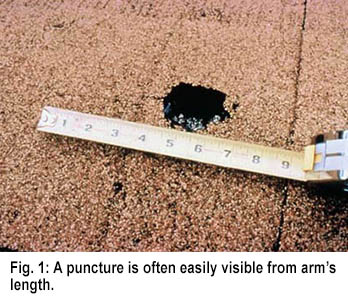Of Apples and Asphalt Comp Shingles: ‘Bruise’ Defined
By Scott Morrison, P.E., Director of Haag’s Research/Testing lab
Ever watch a kid with an apple? If there is a soft spot in the apple, the child will find it by pushing with their tiny fingers… Now imagine an asphalt composition shingle struck by large hail — say 2” hard ice. The shingle is punctured. The site contacted by the hailstone is surrounded by a round or oval fracture, depending on the angle of the impact. Materials within the fracture are broken. Granules are dislodged and the reinforcement is torn. The hail damage is easily visible at more than arm’s length (see Fig. 1).

Next think about a smaller hailstone — say hail that is 1- to 1¼” in diameter, made of hard ice. What happens to the lightweight three-tab asphalt shingle supported over plywood decking if it is struck by such hail? The shingle has the slightest dent, one that is not readily visible but which is perceptible tactilely at the impact site. From arm’s length, we don’t see a fracture in the shingle exposure. Our eyes may be drawn to the impacted area because a few granules are missing. We run our fingers across the tab and feel a slight dent.
How do we tell if the shingle has been damaged by hail? We gently push with finger tips in the shallow dent. If we feel a localized soft spot like that bruise in an apple, we’ve identified broken (fractured or ruptured) reinforcement within the shingle. Structure within the shingle broken by hail constitutes hail-caused damage. Thus: a bruise in a shingle is a fracture that is not evident in the top surface of the shingle but can be distinguished tactilely with finger tips.
Knowing that fractures in shingles caused by impacts initiate in the bottom surfaces of shingles, we can confirm the fracture by examining or feeling the bottom side of the shingle. If the shingle is bonded by sealant, we may gently unseal the shingle (see Fig. 2) and look and/or feel for the fracture (and then re-bond the shingle). One can even go a step further and carefully harvest the shingle and extract its reinforcement with a vapor degreaser (see a short video on that process below). Fractures in reinforcements have their own signatures of damage—impact-caused fractures and strained regions.
So let’s recap. Hail-caused damage to an asphalt shingle includes punctures and bruises. Punctures are obvious visibly. Bruises are not so obvious visibly (see Fig. 3), but they can be confirmed tactilely as localized soft spots in roofing that contain physical damage to the shingle reinforcement…just like a child finds a bruise in an apple.
Scott Morrison, P.E., Director of Haag Research/Testing lab, 10/2015
Scott Morrison specializes in Structural Evaluations, Foundations, Earthborne and Airborne Vibrations, Roofing Systems, Reconstruction Monitoring and Analysis, Research/Testing, and Architectural. He is a primary author of material in the Haag Certified Inspector courses and many of the Haag Damage Assessment Field Guides. See his profile here.
Haag’s ‘Green Machine’: How We Extract Reinforcements to Determine Damage


